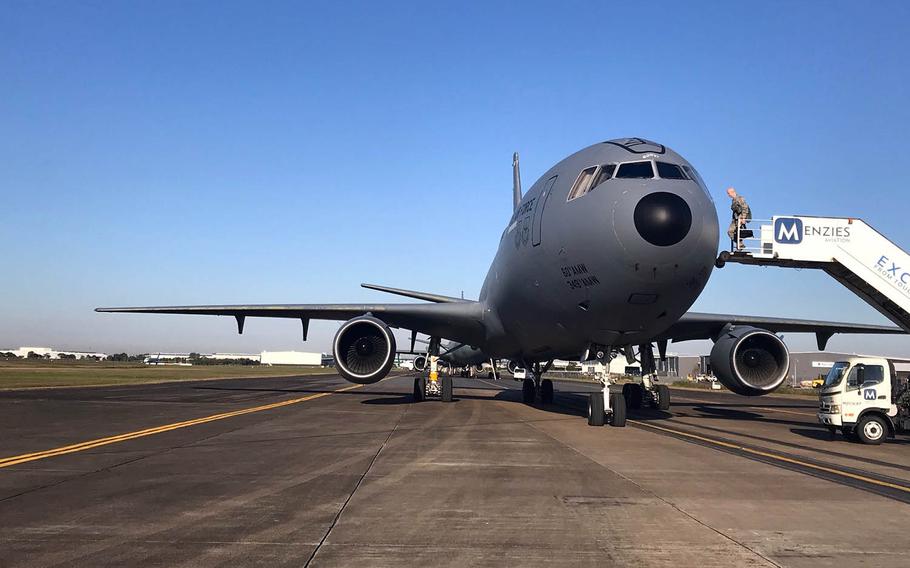
An airman walks aboard a KC-10 Extender at Brisbane International Airport in Australia before a Talisman Sabre air operation, Friday, July 19, 2019. (Caitlin Doornbos/Stars and Stripes)
BRISBANE, Australia — About 100 miles off the Capricorn Coast, Air Force Tech. Sgt. Dave Pingleton sat face-to-face with fighter pilots flying just feet below his KC-10 Extender on Friday morning during Talisman Sabre, a joint military exercise.
As the boom operator, it’s his job to pump thousands of gallons of “freedom juice” — what air refueling crews call jet fuel — into aircraft so they can stay in the fight without returning to the ground.
“The fight can’t be done without the gas,” said Pingleton, who is assigned to Travis Air Force Base, Calif. “If we can’t get the gas to the fighters, it wastes critical time to land at the base, refuel and get back to the fight.”
The first aircraft to approach was a Royal Australian Air Force EA-18G Growler, an electronic attack jet. Usually, a U.S. KC-10 refuels only American aircraft, but allied forces practice working together during Talisman Sabre.
This year, the monthlong air, land and sea exercise led by the U.S. and Australia also includes forces from Canada, Japan, New Zealand and the United Kingdom, with representatives from the Indian and South Korean militaries observing.
“The Australian air force has a pretty stout refueling tanker program as they stand here,” Pingleton said. “But it’s very important for us to work together as a team and take the things that the Australian air force is good at and the things that the Air Force is good out and blend them all together.”
Running a flying gas station can be a dangerous job. In December, six Marine aviators stationed in Iwakuni, Japan, died after a midair collision between a KC-130J tanker and an F/A-18D Hornet during a refueling exercise over the Philippine Sea.
“We make it as safe as we can,” said the KC-10’s pilot, Maj. John Langley, also of Travis Air Force Base. “Obviously, you have two planes touching in the sky; there’s a little risk there
During the three-hour KC-10 flight, Pingleton fueled about 10 aircraft, including F-22 Raptors and F/A-18E and F model Super Hornets launched from Royal Australian Air Force Base Amberly near Brisbane and the USS Ronald Reagan in the Coral Sea.
The KC-10s are launched from Brisbane International Airport, offering a rare treat for commercial jet passengers catching peaks out aircraft windows.
In one of the Raptors, a U.S. flag and an Australian flag decorated the dashboard. The American jet was flown by Australian air force Flight Lt. Paul Anderton, who is on a three-year assignment at Joint Base Elmendorf-Richardson in Alaska as part of a U.S. exchange program.
A foreign pilot flying a U.S. fighter jet is an uncommon feat, said Capt. AnnMarie Annicelli, a spokeswoman for Talisman Sabre and the 5th Air Force.
“It is rare because in the U.S., we tend to keep the aircraft close to us,” she said.
During the operations Friday, the airspace was divided into three regions, Langley said. The KC-10 flew in a racetrack pattern for pilots to approach in one area, while another space was designated for climbing and descending. A third area was for fighter jets carrying out their battle orders.
The exercise scenario called for fighter jets to provide air support to coalition forces combatting the fictional Pacific country of Kamaria, which invaded the fictional island of Legais. Australia’s Shoalwater Bay Training Area stood in as Legais.
Shoalwater Bay sits on the Capricorn Coast, named for its location along the Tropic of Capricorn. Its deep-blue waters covering the Great Barrier Reef made for a stunning backdrop for the view from Pingleton’s seat in the KC-10.
“It is business, but I will not hesitate to take a look out the window and take a look at the beautiful coast every once in a while,” he said.
So far, the pilots have been practicing “one-on-one dog fighting with F-18 Super Hornets, Growlers and F-22 Raptors to familiarize with the airspace,” Group Capt. Stephen Chappell, task unit commander at Amberly, said in a Defence Department statement.
KC-10s will continue to fly throughout Talisman Sabre as air operations continue — and intensify.
“Over the next few weeks we are training to effectively fight for and gain control of the air and electromagnetic spectrum, with the goal of simulating strike weapons on both land and maritime enemy assets as part of the exercise scenario,” Chappell said in the statement.
Langley said he appreciated being “a very small part of a huge exercise.”
“There’s over 30,000 people between Australia and the U.S. participating and we’re just a little sliver of that, but I like my part,” he said.
Talisman Sabre is expected to continue until early August.